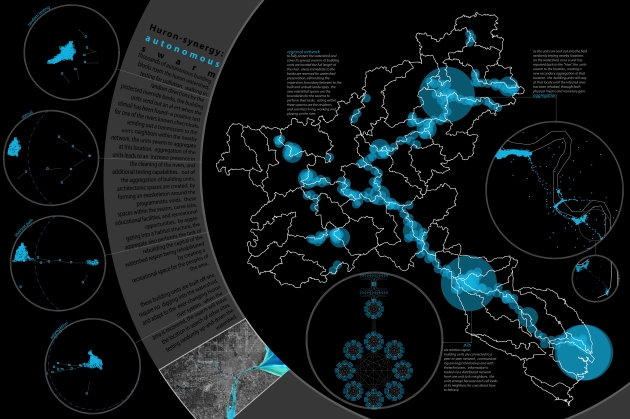
thousands of autonomous building blocks roam the huron watershed, testing for pollution. walking in random directions near the protected riverside banks, the building units send out an alert when the stimuli has been found–a positive test for one of the rivers known pollutants. sending out a wireless transmission to the the units neighbors within the nearby network, the units swarm to aggregate at this location. aggregation of the units leads to an increased presence in the cleaning of the river, with additional testing capabilities. out of the aggregation of building units, they assemble themselves around architectonic spaces by forming an exoskeleton around the programmtic voids. these spaces within the swarm are carved; labs, educational facilities, and recreational opportunities. by aggregating into a habitable structure, the aggregate also performs the task of rebuilding the capital for watershed region being rehabilitated, by creating a recreational space for the peoples of the region. these building units are built off site, require no digging into the watershed, and adapt to the ever-changing huron river system. when the area is recovered, the swarm will leave the location in search of other sites, testing randomly up-and-down the watershed. to fully protect the watershed and cover its spread, swarms of building units are located the full ength of the river. areas immediate to the banks are reserved for watershed preservation, eliminating the impervious boundary between to the built and unbuilt landscapes. the new interstitial spacs are the boundaries for the swarms to perform their tasks. acting within these swarms are the residents and scientists living, working, and playing on the river. as the units are sent out into the field, randomly testing nearby locations on the watershed, a unit will report back to the “hive”, at which point the units swarm to the location creating a new secondary aggregation at that location. the building units will stay at that locale until the infected area has been rahabed, through both phsyical and monetary means. via wireless signal, building units are connected to a peer-to-peer network, communicating amongst themselves and with the technicians. information is traded via a distributed network from one unit to its neighbors. the units emerge because each cell looks at its neighbors for cues about how to behave.






Leave a comment